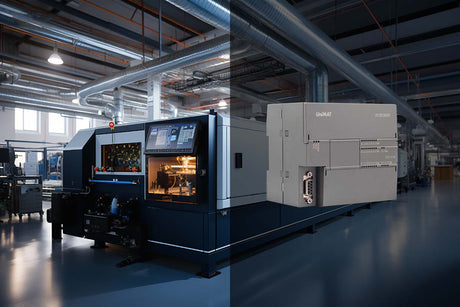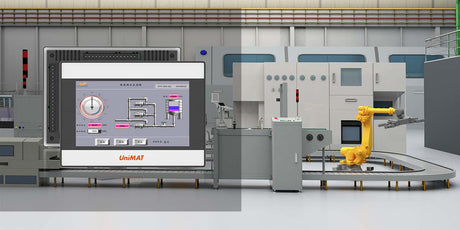En los edificios inteligentes y las instalaciones industriales actuales, los controladores lógicos programables (PLC) se han convertido en la columna vertebral del control eficiente de HVAC (calefacción, ventilación y aire acondicionado). Este artículo explica cómo los PLC optimizan las operaciones de HVAC, destaca la experiencia de Unimat PLC en el campo y muestra sus innovadoras soluciones impulsadas por IA a través de aplicaciones del mundo real como la fábrica de vehículos eléctricos de Xiaomi y las calderas eléctricas industriales.

¿Qué es un PLC y por qué utilizarlo para el control de HVAC?
Un PLC es una computadora de grado industrial diseñada para automatizar procesos mediante el monitoreo de entradas (por ejemplo, sensores de temperatura, interruptores de presión) y la activación de salidas (por ejemplo, ventiladores, válvulas) según una lógica preprogramada. Para los sistemas HVAC, los PLC ofrecen tres ventajas clave:
Control de precisión
Los PLC ajustan continuamente los equipos (como enfriadores o manipuladores de aire) para mantener niveles exactos de temperatura y humedad, evitando el desperdicio de energía en ajustes manuales.
Gestión centralizada
Integre todos los componentes HVAC (flujo de aire, serpentines de calefacción, torres de enfriamiento) en un solo sistema para un funcionamiento sincronizado.
Detección de fallas y seguridad
Apague automáticamente los equipos que funcionan mal (por ejemplo, motores sobrecalentados) y alerte a los técnicos mediante paneles de control HMI (interfaz hombre-máquina).
Cómo funciona la lógica PLC en sistemas HVAC: un ejemplo paso a paso
Analicemos una secuencia básica de HVAC controlada por PLC:
Entradas:
Los sensores de temperatura detectan que la temperatura en la habitación está a 28 °C (por encima del punto de ajuste de 24 °C).
Los sensores de CO₂ muestran niveles elevados.
Procesamiento lógico del PLC:
SI temperatura>24°C Y CO₂>800 ppm→Activar refrigeración+aumentar entrada de aire fresco.
SI la humedad es > 60 % → Activar el deshumidificador.
Salidas:
Ponga en marcha el enfriador.
Compuertas abiertas para aire exterior.
Ajuste la velocidad del ventilador mediante VFD (variadores de frecuencia).
Este sistema de circuito cerrado garantiza un confort óptimo al tiempo que minimiza el consumo de energía.
PLC Unimat en acción: Casos prácticos desde Xiaomi hasta calderas industriales

1. Fábrica de vehículos eléctricos inteligentes Xiaomi: automatización escalable de HVAC
En la planta de vehículos eléctricos de última generación de Xiaomi, la solución PLC+HMI de Unimat gestiona una compleja red HVAC que abarca líneas de producción, talleres de pintura y áreas de ensamblaje de baterías.
Características principales:
Monitoreo en tiempo real de más de 500 sensores (temperatura, niveles de partículas).
Control de flujo de aire adaptativo para evitar la contaminación en salas blancas.
Ahorro de energía del 18% mediante predicción de carga impulsada por IA.
2. Calderas eléctricas industriales: precisión y fiabilidad
Los PLC Unimat regulan calderas eléctricas de alta potencia utilizadas en sistemas de calefacción urbana:
Flujo de trabajo lógico:
Equilibrio de fases para evitar la sobrecarga de la red.
Alertas de mantenimiento predictivo para elementos de calefacción.
Integración perfecta con sistemas SCADA para control remoto.
El futuro de Unimat impulsado por IA: HVAC más inteligente, costos más bajos
Al combinar décadas de experiencia en HVAC con IA, Unimat ahora ofrece sistemas PLC de autoaprendizaje que:
Analizar datos históricos para predecir cargas máximas y precalentar/enfriar espacios.
Detecta anomalías (por ejemplo, fugas de refrigerante) un 30 % más rápido que los sistemas tradicionales.
Optimice el uso de energía de forma dinámica, reduciendo las facturas de servicios públicos hasta en un 25%.
¿Por qué elegir Unimat para su proyecto HVAC?
Historial comprobado: marcas globales como Xiaomi confían en nosotros para el control de HVAC de misión crítica.
Hardware preparado para IA : PLC preparados para el futuro con capacidades de aprendizaje automático integradas.
Soporte de extremo a extremo: desde el diseño hasta la optimización posterior a la instalación.
Optimice su sistema HVAC hoy: comuníquese con Unimat para explorar soluciones PLC adaptadas a las necesidades de sus instalaciones.









